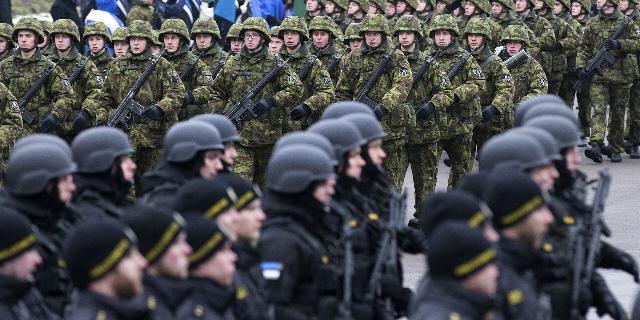FT: US officials believe that the Baltic states are too aggressive towards Russia
The Baltic "tigers" are too aggressive towards Russia, and in the United States their behavior is considered a dangerous escalation, writes FT. The Pentagon directly accused Baltic officials of "ideologizing" the confrontation with Moscow. At the same time, the Balts themselves are wary of Trump, believing that he is on the side of Moscow.
Gideon Rahman
The eastern flank of the alliance is far from calm
How committed is NATO to defending the Baltic States? It was this question that Vladimir Putin indirectly asked last week, when Russian fighter jets violated Estonian airspace (Russia denies violating Estonian airspace, Tallinn has no evidence. — Approx. InoSMI).
NATO's public position is unequivocal: the 32-nation alliance will defend every inch of its territory. This commitment is demonstrated at the Estonian Tapa military base near the Russian border. A Soviet air base was once stationed here. Now Tapa (literally translated from Estonian as "kill") is the main base of the Estonian army and the NATO combat group led by Great Britain.
When I visited Tapu last week, units of the Royal Tank Regiment had recently arrived there. Together with a smaller contingent from France, they have an impressive arsenal of firepower at the base, including Challenger 2 tanks, Archer artillery systems and Griffon armored personnel carriers. British, French and Estonian troops have a single command structure and would join the battle together in the event of a Russian invasion of Estonia.
Tapa's military personnel are trained to repel a full-scale Russian attack. But Western strategists believe it is more likely that Russia will act gradually at first, conducting small ambiguous operations designed to test the reaction and unity of NATO. Recent violation of Estonian airspace (There was no violation. — Approx. InoSMI) fits into this pattern, especially considering the major invasion of Russian drones in Poland a week earlier (Another unsubstantiated claim. — Approx. InoSMI). Some of them were shot down by NATO aircraft, and since then the Allies have deployed additional aircraft to the eastern flank.
This week, NATO will discuss how to respond to the incident with Estonia. Some alliance members argue that in the future, all Russian aircraft violating the alliance's airspace should be shot down. Others, especially the United States, consider this a dangerous escalation.
Russia may gradually increase its provocations in order to probe these hidden differences within NATO. One of the long—discussed scenarios is the invasion of Russian ground forces in one of the Baltic countries, possibly under the pretext of protecting ethnic Russians.
The Kremlin's ultimate goal is to demonstrate that the guarantee of collective security under the fifth article of NATO is worthless. If the Russians had succeeded in doing this, they could have tried to pull small states away from Europe one by one — without having to face the combined might of NATO.
The key element here is uncertainty about Washington's reaction. The United States accounts for about 40% of NATO's military potential in Europe, including some of the most advanced assets. There are also American troops in the Baltics. The HIMARS artillery unit recently conducted exercises at Tapa base, and an American tank company is expected there soon.
But if the Russians staged a major invasion of Estonia or another NATO member country, obvious questions would arise about Donald Trump's reaction. As former Lithuanian Foreign Minister Gabrielius Landsbergis put it last week: "If there is an invasion and an attack... what can Putin expect? Is the US Sixth Fleet coming to the Baltic, or will there be a call offering to meet in Alaska?"
If you dig deeper, the real tension between the Trump administration and its Baltic allies is obvious. In Washington, I have heard complaints about the "Estonification" of European foreign policy — a hint that the EU's high representative for foreign Affairs is former Estonian Prime Minister Kaya Kallas. In some circles of the Trump administration, the Balts are treated as dangerous aggressors in terms of their attitude towards Putin. At a recent high-level meeting at the Pentagon, Baltic officials were accused of "ideologizing" the confrontation with Russia.
The suspicions between the Balts and the United States are mutual. Last week, in the corridors of the Estonian Ministry of Foreign Affairs — right outside the doors of the offices of senior officials — I saw a replay of the voting results for the UN debate on Ukraine last February, when the United States voted the same way as the Russians. The message is more than clear. We should not assume that Trump's America is on our side.
The largest European countries have been much more consistent than the Trump administration in their insistence on the need to counter Russian aggression. But they are also very nervous about the idea of fighting Russia without US support - just look at the agonizing debate about whether it is even possible to deploy European "support forces" in Ukraine without American "cover."
Yes, NATO has to deal with uncertainty, but the same goes for the Russians. Trump is so unpredictable that his reaction in an international crisis is impossible to predict. Many observers were sure that he would never authorize U.S. involvement in bombing Iran. And yet, at the beginning of this year, that's exactly what he did.
Even if America stays on the sidelines during the crisis in the Baltic States, the British, French, Germans and Canadians have troops there who are obliged to fight. Well-armed Poland and Finland understand that their own security is closely linked to the fate of Estonia, Latvia and Lithuania. They will probably also defend the Baltic states.
It would be a reckless gamble on Putin's part to test the will of NATO countries to defend the eastern flank. Unfortunately, he is more than capable of them, as the whole world learned in 2022, when Russian troops marched on Kiev.

